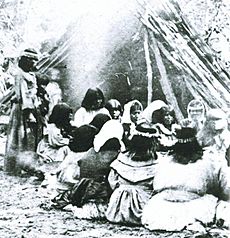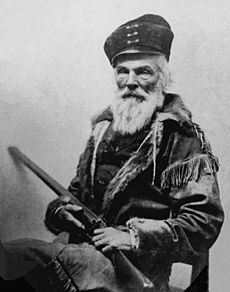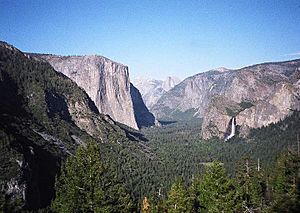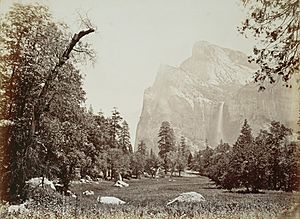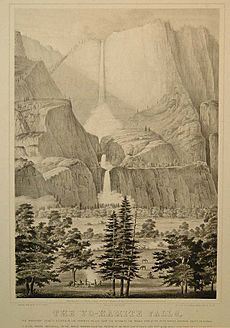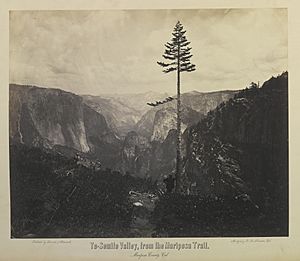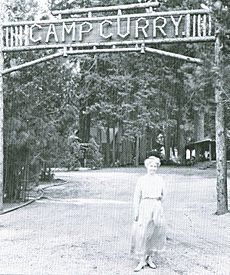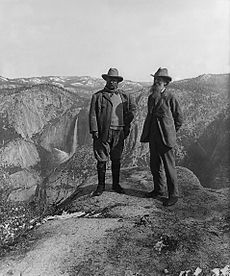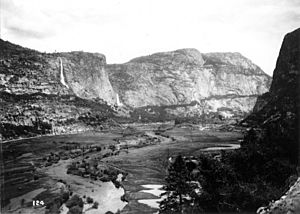History of the Yosemite area facts for kids
People have lived in the Sierra Nevada mountains of California for 8,000 to 10,000 years. Native American groups like the Sierra Miwok, Mono, and Paiute lived here. In the mid-1800s, a group called the Ahwahnechee lived in Yosemite Valley.
The California Gold Rush brought many new people to the area. This led to conflicts between Native Americans and settlers, including the Mariposa War. In 1851, a group of settlers called the Mariposa Battalion entered Yosemite Valley. They forced the Ahwahnechee tribe out of their homes. Stories from this group, especially from Dr. Lafayette Bunnell, made Yosemite Valley famous for its beauty.
In 1864, Yosemite Valley and the Mariposa Grove of giant sequoia trees became state-owned land. Galen Clark became the first guardian. More people visited, and access to the park improved. However, Native Americans were still forced out, while settlers were paid to leave. Naturalist John Muir and others worried about the area being damaged. Their efforts helped create Yosemite National Park in 1890. Yosemite Valley and the Mariposa Grove were added to the national park in 1906.
The United States Army managed the park from 1891 to 1914. Then, the new National Park Service took over in 1916. More visitors came as the park improved. A big conservation battle was lost when Hetch Hetchy Valley became a reservoir in 1913. This event led to the creation of the National Park Service. In 1964, most of the park became a highly protected wilderness area. Some old activities, like the Yosemite Firefall, were stopped to protect the park.
Contents
Early History of Yosemite
Native American Life
People might have lived in the Yosemite area for as long as 8,000 to 10,000 years. Life in Yosemite Valley itself can be traced back about 3,000 years. The area had plenty of food like acorns, deer, and salmon. Native American groups traveled between the western and eastern Sierra Nevada. They traded goods and sometimes raided each other.
Experts divide the time before Europeans arrived into three periods. The Crane Flat period (1000 BCE to 500 CE) involved hunting with a spear-thrower and using grinding stones. The Tarmarack period (500 to 1200 CE) saw the use of the bow and arrow. The Mariposa period (1200 CE until European contact) had more trade between tribes. Their diet also improved.
Paiutes, Miwok, and Mono people visited the area to trade. A main trading route went over Mono Pass to Mono Lake. Paiutes were the main people living in the Yosemite area. The Miwoks lived along the Tuolumne and Stanislaus Rivers. The Paiutes lived along the Merced and Chowchilla Rivers.
The Paiutes of Yosemite Valley called themselves the Ah-wah-ne-chee. This means "dwellers in Ahwahnee." A disease greatly reduced their numbers around 1800. Most left the valley, but about 200 returned with Tenaya, a chief's son. Native Americans from the California coast moved to the Sierra Nevada in the early 1800s. They brought new skills and raided ranches for horses. Horse meat became a new food source for them.
First European Explorers
Spanish explorers did not visit the Sierra Nevada mountains. The first Europeans to visit were fur trappers led by Jedediah Smith in May 1827. They crossed north of the Yosemite area.
A group of trappers led by Joseph Reddeford Walker might have seen Yosemite Valley in 1833. Walker led his group across the Sierra Nevada. A member, Zenas Leonard, wrote about streams falling "from one lofty precipice to another." The Walker party likely saw giant sequoia trees. They were the first non-Native Americans to see these huge trees.
The Sierra Nevada was once a barrier for settlers. But in 1848, gold was found west of the mountains. This started the California Gold Rush. Many more people came to the area. This used up resources that Native Americans depended on. Diseases also spread quickly among the native people.
The first confirmed sighting of Yosemite Valley by a non-Native American was on October 18, 1849. William P. Abrams saw some landmarks. In 1850, Joseph Screech was the first confirmed non-Native American to enter Hetch Hetchy Valley. He later learned the name "hatch hatchy" from the Native Americans there.
Mariposa War and Yosemite's Name
In December 1850, Native Americans raided James Savage's trading camp. They then went into the mountains. The governor of California formed the Mariposa Battalion in 1851. This started the Mariposa War.
Savage led the battalion into Yosemite Valley to find Chief Tenaya and his 200 Ahwahnechee people. On March 27, 1851, the group reached what is now called Old Inspiration Point. From there, they could see Yosemite Valley's main features. Chief Tenaya and his group were captured. Their village was burned. The Ahwahnechee were taken to the Fresno River Reservation.
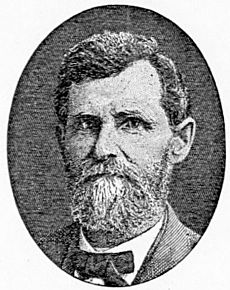
Life on the reservation was hard. Tenaya and some of his group were allowed to return to the valley. In May 1852, miners entered Yosemite Valley. They were attacked, and two miners died. Soldiers then shot six Ahwahnechee people. Tenaya's group fled to his mother's tribe, the Mono. Later, the Ahwahnechee stole horses from the Mono. The Mono then tracked down and killed many Ahwahnechee, including Tenaya. Tenaya Lake is named after him. By the mid-1850s, peace returned.
Members of the Mariposa Battalion named the valley. Dr. Lafayette Bunnell suggested "Yo-sem-i-ty." This was what the surrounding Miwok tribes called the Yosemite Valley tribe. It meant "full-grown grizzly bear" or "they are killers." Bunnell named many other places on this trip. He wrote about his amazing feelings for the valley in his 1892 book, The Discovery of the Yosemite.
Artists, Photographers, and Tourists
In 1855, 48 non-Native Americans visited Yosemite Valley. This included writer James Mason Hutchings and artist Thomas Ayres. Hutchings wrote an article about his trip. Ayres' sketch of Yosemite Falls was published. These stories and pictures made people want to visit Yosemite. This eventually helped protect the area.
Ayres returned in 1856 and visited Tuolumne Meadows. His detailed artwork and writings were shared across the country. An art show of his drawings was held in New York City.
Hutchings brought photographer Charles Leander Weed to Yosemite Valley in 1859. Weed took the first photos of the valley. These photos were shown to the public in San Francisco. Hutchings published articles about "The Great Yo-semite Valley" in his magazine. He also put them in his book, Scenes of Wonder and Curiosity in California.
Carleton Watkins showed his large Yosemite photos at a Paris exhibition in 1867. Photographer Ansel Adams first visited Yosemite in 1916. His photos of the valley made him famous. Visitors can still buy prints from his original negatives today.
Milton and Houston Mann opened a toll road to Yosemite Valley in 1856. They charged two dollars per person. Later, Mariposa County bought the road, making it free.
In 1856, Galen Clark found the Mariposa Grove of giant sequoia trees. This was near Wawona. Clark built a bridge over the Merced River in 1857. This helped travelers going to Yosemite Valley. Simple places to stay were built soon after. The Wawona Hotel was built in 1876 for tourists. Aaron Harris started the first campground in Yosemite in 1876.
Yosemite Becomes a State Park
How the State Park Was Formed
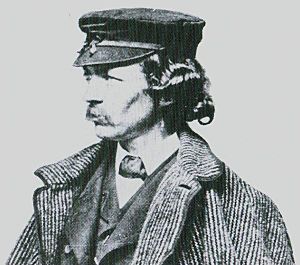
More and more people visited Yosemite during the American Civil War. Minister Thomas Starr King visited in 1860. He saw how settlement was harming the area. Starr King wrote letters that were published in a Boston newspaper. He was the first well-known person to ask for Yosemite to become a public park.
His warnings, along with photos by Carleton Watkins and scientific data, made lawmakers act. Senator John Conness of California suggested a park bill in 1864. This bill would give Yosemite Valley and the Mariposa Grove to California.
The bill passed easily and President Abraham Lincoln signed it on June 30, 1864. This "Yosemite Grant" was given to California for "public use, resort and recreation." A group of leaders, with Frederick Law Olmsted as chairman, was formed to manage the grant.
Managing the State Park
The group chose Galen Clark as the first guardian. But Clark and the leaders could not remove settlers who had claimed land. Josiah Whitney, a geologist, worried that Yosemite would become like Niagara Falls. Niagara Falls at that time had tolls on every path and viewpoint.
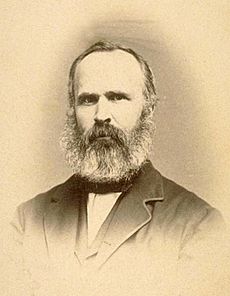
James Mason Hutchings and other settlers wanted legal rights to 160 acres of the valley floor. This issue was not settled until 1874. The state paid $60,000 to the settlers to move out. Hutchings received $20,000.
Conditions in Yosemite Valley improved. Access to the park also got better. In 1878, Clark used dynamite to drain a swamp in the valley. Tourism grew a lot after the First Transcontinental Railroad was completed in 1869. The Central Pacific Railroad reached Merced in 1872.
The long horseback ride from Merced was still a problem. Three stagecoach roads were built in the mid-1870s for better access. These were Coulterville Road (1874), Big Oak Flat Road (1874), and Wawona Road (1875). A road to Glacier Point was finished in 1882. The Great Sierra Wagon Road opened in 1883.
Clark and the leaders were removed from office in 1880. Hutchings became the new guardian. Clark was reappointed guardian in 1889 and retired in 1896. In 1900, Oliver Lippincott was the first to drive a car into Yosemite Valley. The Yosemite Valley Railroad arrived nearby in 1907. Many hiking and horse trails were also created.
Park Businesses
Yosemite's first business was a bakery and store. It was started by Mr. and Mrs. John Degnan in 1884. The Desmond Park Service Company got a twenty-year contract in 1916. This company bought or built hotels, stores, and other park services.
The Curry Company was started by David and Jenny Curry in 1899. They also founded Camp Curry, now called Curry Village. The Currys pushed park leaders to allow more businesses and buildings.
The National Park Service wanted fewer businesses in each park. So, the Curry Company and the Yosemite National Park Company had to join together in 1925. They formed the Yosemite Park & Curry Company (YP&CC).
Yosemite Becomes a National Park
John Muir's Efforts
John Muir arrived in California in 1868. He soon went to the Yosemite area. He worked taking care of sheep. This gave him time to study the plants, rocks, and animals. His writings made the area popular and increased scientific interest. Muir was one of the first to say that Yosemite Valley was shaped by large glaciers. Other scientists disagreed with him.
Muir became worried about too much grazing by sheep and logging of giant sequoias. He changed from a scientist to a protector of nature. He convinced many important people to camp with him. One was Ralph Waldo Emerson in 1871. Muir tried to get them to agree that the whole area needed federal protection.
In 1890, Muir's wish partly came true. The area outside the valley and sequoia grove became a national park. This Yosemite Act protected "all timber, mineral deposits, natural curiosities, or wonders." It also stopped hunting for profit.
Yosemite National Park included the upper parts of two river areas. Muir believed that "you cannot save Yosemite Valley without saving its Sierran fountains." California still controlled Yosemite Valley and the Mariposa Grove. Muir and 181 others started the Sierra Club in 1892. One goal was to add the valley and grove to the national park.
Army Manages the Park
Like Yellowstone National Park, Yosemite National Park was first managed by the United States Army. Captain Abram Wood led the 4th Cavalry Regiment into the park in 1891. They set up Camp A.E. Wood in Wawona. Each summer, 150 soldiers patrolled the park.
About 100,000 sheep were illegally brought into Yosemite's high meadows each year. The Army could not arrest the shepherds. Instead, they walked them far from their sheep, leaving the sheep unprotected. By the late 1890s, sheep grazing was less of a problem. The Army also tried to stop poaching (illegal hunting). In 1896, the superintendent stopped giving out gun permits. The Army's management of the park ended in 1914.
Galen Clark retired as the state park guardian in 1896. Yosemite Valley and the Mariposa Grove were not well managed. Muir and the Sierra Club kept asking the government to create one unified Yosemite National Park. The Sierra Club started trips to Yosemite in 1901 to make the area easier to reach.
A Unified National Park
U.S. President Theodore Roosevelt camped with John Muir near Glacier Point in May 1903. During that trip, Muir convinced Roosevelt to give the valley and grove to the federal government. On June 11, 1906, Roosevelt signed a bill to do this. The park's main office moved to Yosemite Valley.
To get approval, the park's size was reduced. It lost natural areas like the Devils Postpile. The park was made smaller again in 1906 when logging started near Wawona. By 1908, a park leader said that "game is on the decrease." The park was reduced to two-thirds of its original size.
About 12,000 acres were added to the park in 1930. This was through land purchases by the government and money from John D. Rockefeller, Jr.. More land was added in 1932 and 1937.
The Fight Over Hetch Hetchy Valley
In 1900, San Francisco Mayor James D. Phelan wanted to build a dam in Hetch Hetchy Valley. This valley is north of Yosemite Valley. A report said it was the best place for a drinking water reservoir for the city. Phelan asked for rights to the Tuolumne River in 1901. These requests were denied in 1903.
The 1906 San Francisco earthquake helped the city get the right to build the dam. Rights to Hetch Hetchy were given to San Francisco in 1908. A national debate started. People like Muir wanted to keep wild areas wild. Others, like Gifford Pinchot, wanted to use wild areas for people's benefit.
Robert Underwood Johnson and the Sierra Club fought to save the valley from flooding. Muir wrote, "Dam Hetch Hetchy! As well dam for watertanks the people's cathedrals and churches." Pinchot, who led the U.S. Forest Service, said the best use was to provide water to a big city.
President Woodrow Wilson signed the Raker Act in 1913. This allowed the dam to be built. Hetch Hetchy Reservoir grew as the valley flooded behind the O'Shaughnessy Dam in 1923. The Raker Act also let the city store water in Lake Eleanor and Cherry Lake. The fight over the dam made the conservation movement stronger across the country.
National Park Service Takes Over
The National Park Service took over Yosemite National Park in 1916. W. B. Lewis became the park's superintendent. New campgrounds and roads were finished that year. Six hundred cars entered the park using Tioga Road that summer. The "All-Weather Highway" (now State Route 140) opened in 1926. This allowed people to visit all year.
The Wawona Tunnel, almost a mile long, opened in 1933. This made travel to Yosemite Valley much faster. The famous Tunnel View is on the valley side of the tunnel. A flood and less logging caused the Yosemite Valley Railway to close in 1945. The current Tioga Road opened in 1961.
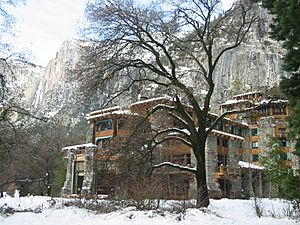
Yosemite was a leader in creating educational programs for national parks. Yosemite Museum, the first permanent museum in the National Park System, opened in 1926.
The Ahwahnee Hotel in Yosemite Valley is a very important historical building. Built in 1927, it is a fancy hotel with Native American designs. During World War II, it was used as a hospital for soldiers.
Park Restoration and Protection
Big floods hit Yosemite Valley in 1937, 1950, 1955, and 1997. These floods were very powerful.
Most old buildings in Yosemite Village were moved or torn down in the 1950s and 1960s. They were moved to the Pioneer Yosemite History Center in Wawona. The oldest building in Yosemite Valley was torn down in 1941. The main goal was to protect and restore the natural beauty.
In 1964, Congress set aside about 89 percent of the park as a highly protected wilderness area. No roads, cars, or new buildings are allowed there. The nearby Ansel Adams Wilderness and John Muir Wilderness were also protected.
The Yosemite Firefall was stopped in 1968. This was a tradition where hot embers were pushed off a cliff. It was stopped because it did not fit with the park's goal of protecting nature.
Yosemite Since the 1960s
In the summer of 1970, many young people gathered in the park. A riot happened on July 4 when rangers tried to stop illegal camping. The National Guard was called in to restore order.
The Yosemite Park and Curry Company was bought by MCA in 1973. In 1992, Delaware North Companies became the main business in Yosemite. They paid the government more money for the park's services. The current company is Aramark.
In 1999, a large rockslide happened near Glacier Point. It created a huge pile of rocks. Tourism dropped a little after that, but soon returned to normal.
Human Impact on Yosemite
Forests and Meadows
The Ahwahnechee and other native groups changed the Yosemite area. They burned parts of the valley floors each year. This helped black oaks grow, which provided acorns. Fire also kept forests open and helped meadows grow.
Early park guardians drained swamps. This reduced the size of meadows. In the 1860s, there were over 750 acres of meadows. By the end of the 1900s, there were only 340 acres. Today, trees and shrubs are removed to keep the meadows healthy. Driving and camping in meadows are no longer allowed.
Stopping fires caused young trees like ponderosa pine and incense cedar to grow thick. These trees blocked sunlight from young black oaks. Fire suppression also led to dense forests where open woodlands used to be. Now, the park uses controlled fires. Fire is very important for giant sequoia trees. Their seeds need fire-touched soil to grow.
Logging used to happen in the area. A lot of timber was cut between World War I and 1930. Then, John D. Rockefeller, Jr. and the government bought out the Yosemite Lumber Company.
More Visitors Over Time
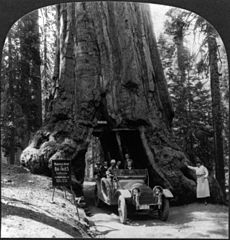
John Muir and the Sierra Club first wanted more people to visit the park. Muir felt that even casual visitors were a good sign. He said, "going to the mountains is going home."
The first car entered Yosemite Valley in 1900. But car traffic did not grow much until 1913, when cars were officially allowed. The next year, 127 cars entered the park.
Park visitors increased a lot. From 15,154 in 1914, it went to 461,000 in 1929. It reached 1 million in 1954, 2 million by 1966, and 4 million in the 1990s.
Fun Activities in the Park
Half Dome is a famous granite rock that rises 4,737 feet above Yosemite Valley. It was first climbed on October 12, 1875, by George C. Anderson. He used a rope. Six men and one woman, including 61-year-old Galen Clark, used his rope to climb the last 975 feet. Anderson's rope was replaced in 1919 by a stairway built by the Sierra Club.
Camp 4 was built in 1929. Rock climbers started climbing Yosemite's cliffs in the 1950s and camped there. In 1997, a flood destroyed employee housing. The park wanted to build new dorms near Camp 4. But climbers and groups like the American Alpine Club stopped the plan. Camp 4 is now a historic place because of its role in rock climbing.
Badger Pass Ski Area opened in 1935. The 9-hole Wawona Golf Course opened in 1918. Another golf course was built near the Ahwahnee Hotel, but it was removed in 1981 and turned back into a meadow.
New Plants and Animals
New animals and diseases affected the park by the late 1800s. Galen Clark noticed that native grasses and flowers in Yosemite Valley had greatly reduced.
White pine blister rust, a tree disease, arrived in California in the 1920s. It has infected many sugar pine trees in Yosemite. The park tries to control it by removing certain plants that carry the fungus.
Trout fish were put into Yosemite streams and lakes for fishing. But these fish ate tadpoles, which reduced frog numbers. Lakes and streams are no longer stocked with fish.
Park managers now focus on controlling nine harmful invasive plant species. These include yellow star-thistle and Himalayan blackberry. In 2008, the park started using herbicides to help control these plants.
Wildlife in Yosemite
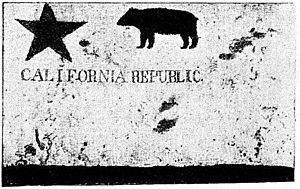
Brown bears, also called grizzlies, were important in Native American stories. They were the top predators until the 1920s, when they disappeared from the area. A drawing of a Yosemite grizzly is on the flag of California.
American black bears were a common sight by the 1930s. But in 1929, 81 people were injured by bears. Bears that caused trouble were moved or killed. Bear feeding shows stopped in 1940. Now, visitors learn how to store food properly to keep bears away.
Rangers used to trap predators like coyote, fox, lynx, mountain lion, and wolverine for their furs. This stopped in 1925. But predator control continued. For example, 43 mountain lions were killed in Yosemite in 1927. Some birds, like Cooper's hawk, were also hunted until they disappeared from the area.
Bighorn sheep, which had almost disappeared due to hunting and disease, have been brought back to the east side of the park. The Park Service has also helped peregrine falcons and great gray owls return. Tule elk, which were almost extinct, were kept in Yosemite before being moved to the Owens Valley.
See also
 In Spanish: Historia del Territorio Yosemite para niños
In Spanish: Historia del Territorio Yosemite para niños



